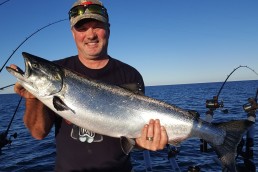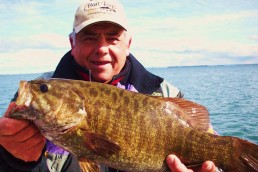Try a Midday Bite for Great Lake Michigan Action
SHARE THIS POST
Trevor and I were just about finished cleaning up from our morning outing. It was a good one as we managed to box 16 nice fish, though several more eluded us. As we readied the boat and grabbed a quick bite, we prepared for our afternoon group. Our morning ended with a mixture of steelhead and kings in 150 feet. The harbor had been busy with boats returning from the morning fishing and traffic exiting the harbor midday is usually reserved for a few charter boats returning with afternoon excursions.
To start the afternoon, we headed right to where the active fish settled. The kings were higher early, but late morning we found active fish deeper. The 15-pound weights on my Traxstech downriggers will get us down deeper.
As Trevor set his corner at 85 feet, his Ugly Stik hoisting his deep Slide Diver rig bent sternly downward and the drag of his Alphamar started screaming!
“Fish!” he shouted. “It’s a big one too!”
Then, the Ugly Stik on my corner rigger popped and just bent down to the water with the drag screaming,
“Another one! I knew that bloody nose would go! It was hot this morning too!” Trevor exclaimed.
I kept setting the poles on my side and moved a few out of Trevor’s way as he scooped the first King. I moved to his side to set the Slide Diver rig back down.
Over the years, I’ve found that more important than the time of day is actually the fishing pressure. Midday periods have very limited fishing pressure, and I like to think that most creatures are the same when it comes to time—just like my dogs at home. Whether you leave them alone for an hour or six hours, they’ll greet you with the same enthusiasm when you get there. Fish are the same, and really have no sense of time. Leave them alone for a little while and they’ll go right back to what they do best: searching for food.
What I like most about the midday departure is space. Very little traffic is there out in the water, and when I set up and troll away from the harbor it seems like I have the lake to myself. It becomes easy to settle into a speed and angle and make corrections to get my bite back going without having traffic to contend with.
For example, there was a very busy Saturday morning with boat traffic and the weather gave us beautiful conditions and lots of anglers were taking advantage of it. But by high noon the lake was pretty vacant and the fish had had a while to settle down for the morning barrage of traffic.
Early-morning fishing can be hectic with fast action at sunrise if you are on the fish. Midday is just a continuation of the late-morning bite, and finding the active fish is the key. In some respects, it’s almost easier because you can get back on the same pattern as you ended the morning with. I try to settle into that same pattern to start out and adjust from there.
Are you enjoying this post?
You can be among the first to get the latest info on where to go, what to use and how to use it!
Midday is also a great time to get steelhead bites. While early hours are primarily spent targeting kings, I like to fish the steelhead when the sun is high and take a few along the way. So as conditions allow, I like to put out a wide spread and cover some water.
That Saturday, we started the afternoon a bit shallower and it wasn’t long before the Slide Diver on my side—now down to 150 feet of line—started pounding.
“Grab that Diver!” shouted Trevor to a fisherman. “That worked yesterday! It just needs to be a bit deeper today!”
As the warm summer kept easing the surface temperatures of Lake Michigan up, the fish seemed to stay out a bit farther, and down a bit deeper.
This was a little early for this tactic, but we could still capture fish if you can understand where the active ones are hiding out.
Just then, Trevor jumped up and yelled, “High Bird! See the steelie jumping?”
We didn’t keep all the baits low.
Steelhead will often stay near the surface where they can target bugs and still attack higher-swimming alewives. While my larger, inside Yellow Bird planer boards are pulling 10-ounce weights with varying long lengths of line to reach the deeper kings, I like to keep at least one or two smaller Bird planers on the outside of my spread, pulling a brightly colored spoon, and usually one with an orange or red on silver to entice the occasional steelhead strike. Some days, during midsummer, several higher baits per side are very effective in capturing those roaming steelhead. Midday is the best time to enjoy the acrobatic action provided by these silver tail-dancers.
To keep more baits in the “fish zones,” I rigged up my Ugly Stik/Alphamar combo with Trilene 100% Professional Braid in 65-pound test. I’m using 10-ounce weights and running them 120 to 250 feet back behind large Yellow Birds to get them down 80 to 150 feet and to keep my flasher/fly and spoons down deep where kings were hanging out. My Slide Divers have the magnum weights and magnum rings to get those well below the 100-foot mark too, if needed. And I have spooled my Traxstech downriggers with 300 feet of cable and have run 15- and 17-pound weights. If the fish go deeper, they will easily handle 26 pounds. I also spooled my downrigger combo with 50-pound-test Trilene Braid and 60 feet of Trilene Professional Fluorocarbon line. Now, I can run my riggers very deep without seeing my line bow way back and the braid telegraphs every bite back to the rod amazingly well when running deep riggers.
As we enjoy the summer, don’t forget to look deep for the kings as the surface temperature heats up. Running flasher/fly combos and glow spoons near thermoclines while setting up down deep can entice hungry king action. I also try to keep a few spoons near the surface to tease some tail-dancing steelhead—there’s nothing like a mixed bag in the cooler.
MWO
SHARE THIS POST
Did you enjoy this post?
You can be among the first to get the latest info on where to go, what to use and how to use it!
Lee Haasch
Capt. Lee Haasch is a charter captain out of Algoma, Wis., with more than 45 years of Great Lakes angling and guiding experience. Haasch has been instructing anglers for over 30 years with education seminars and timely freelance articles.



